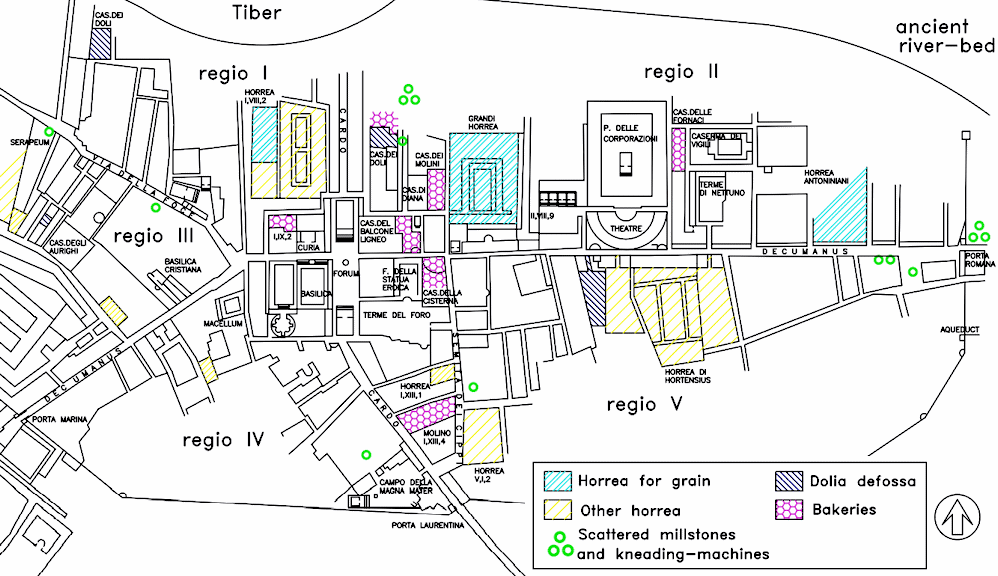The mills-bakeries: description and interpretation
J.Th. Bakker, Leiden, The NetherlandsA study of the Ostian mills-bakeries has been prepared by Boudewijn Sirks, Thea Heres, Bernard Meijlink, Jan van Dalen and Jan Theo Bakker. Three bakeries have been dealt with in detail, following the example of Boersma's Amoenissima Civitas: the Caseggiato dei Molini, Molino I,XIII,4 and the Caseggiato delle Fornaci. The latter building is a newly identified bakery.
Short descriptions are presented of other (possible) bakeries: a building to the east of the Grandi Horrea, a bakery near the Museum, the Caseggiato del Balcone Ligneo, the Caseggiato della Cisterna and Caseggiato I,IX,2. The main criteria for the identification of bakeries are: floors of basalt blocks; basins; the typical large baker's oven on a podium; fragments of millstones and kneading-machines; covered areas for milling and kneading.
The northern part of the bakery in the Caseggiato della Cisterna has been excavated recently (floors of basalt blocks below a late-antique structure).
Two topics that are of particular interest are the date and the distribution of the bakeries. Many bakeries seem to cluster around the Grandi Horrea, and there seems to have been a direct connection between this store-building for corn and the Caseggiato dei Molini. With only one exception the bakeries were installed after the period of Hadrian (during the second century and the Severan period), in buildings that originally consisted of shops and back-areas.
The exception is Molino I,XIII,4. This is very large Trajanic-Hadrianic bakery. It seems to have still been in operation at a very late date. Most of its millstones and kneading-machines were found during the excavation. The road to the east of this building (Semita dei Cippi) was in antiquity called Semita Horreorum. This may well be a reference to the Claudian Grandi Horrea, that are on Via dei Molini, the northern continuation of Semita dei Cippi.
Of particular interest is the relation of the corpus pistorum to the fisc, a subject dealt with in chapter 9 of Bakker, Living and working with the gods. The bakeries around the Grandi Horrea, but also the Caseggiato delle Fornaci (next to the Caserma dei Vigili) and Molino I,XIII,4 (near the Porta Laurentina) may well have worked for the fisc.
They would have supplied bread to the vigiles (Cas. delle Fornaci) and to Imperial slaves. The output however seems to have been far greater. This suggests that there may have been distributions of free corn in Ostia (note that in our view the bakers of the corpus in Rome processed the corn of the frumentationes). The corn in the Grandi Horrea may have been a one-year supply for a little over 10.000 people.

This plan of Ostia shows the distribution of:
- horrea for corn - light blue
- dolia defossa - dark blue
- other depots - yellow
- bakeries - purple
- isolated finds of millstones and kneading-machines - green